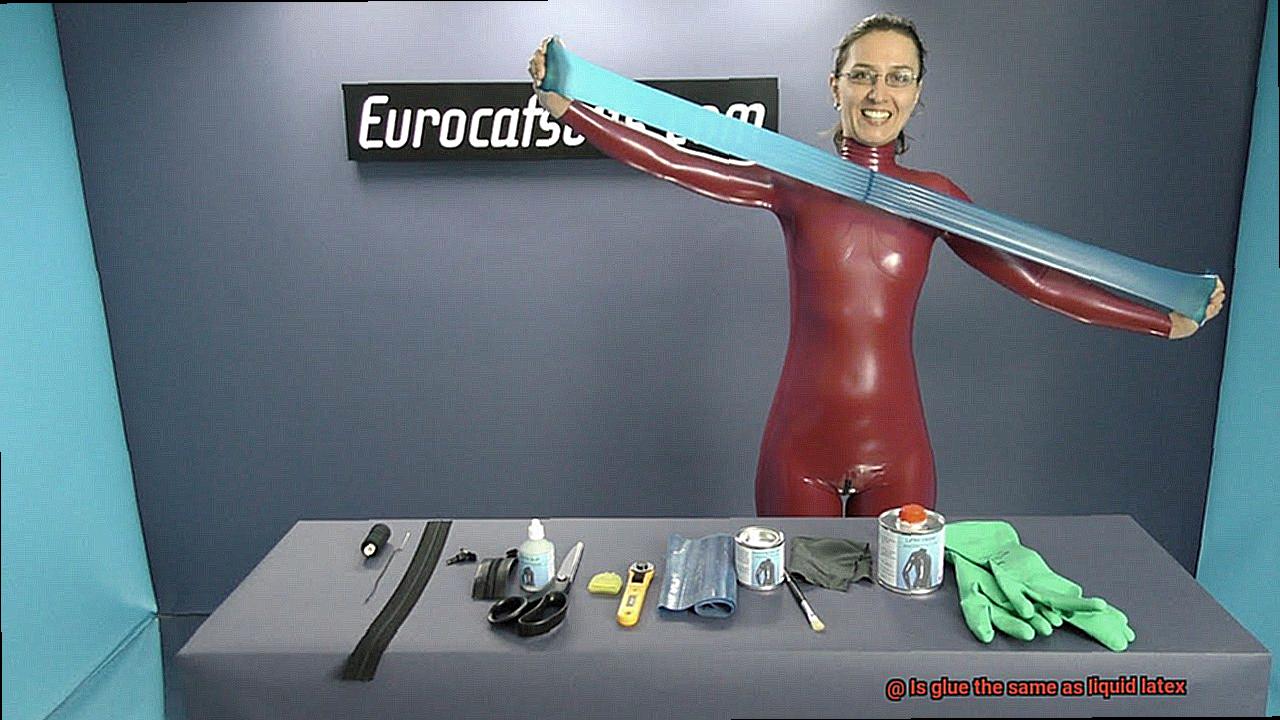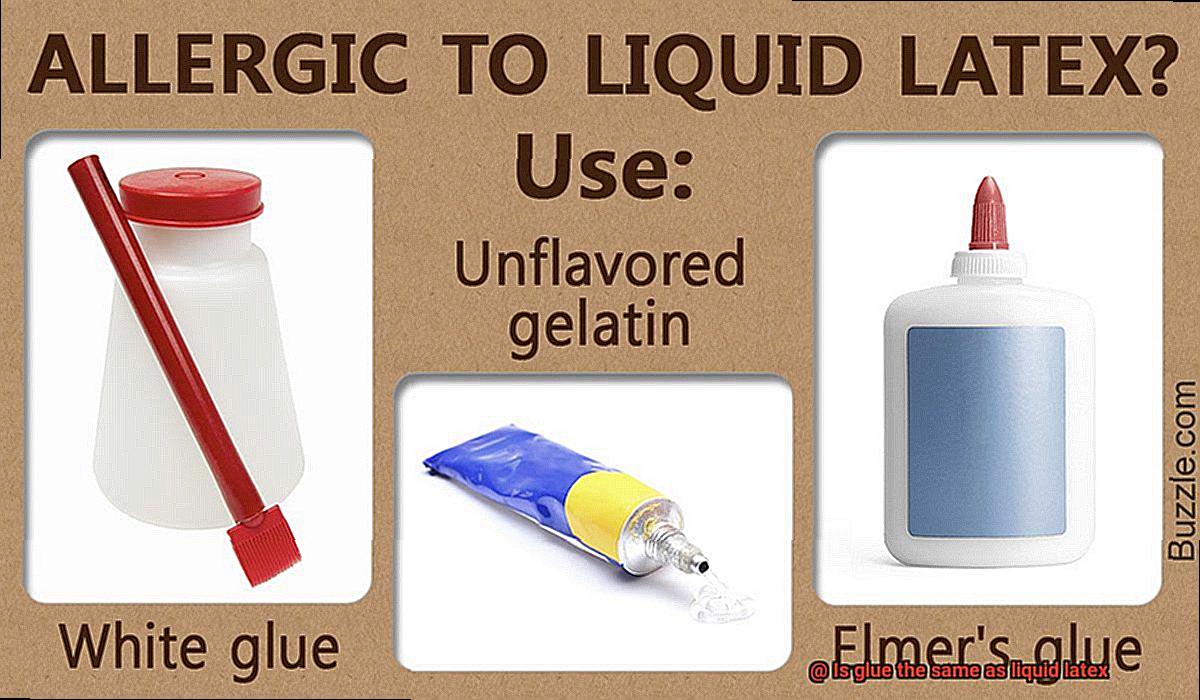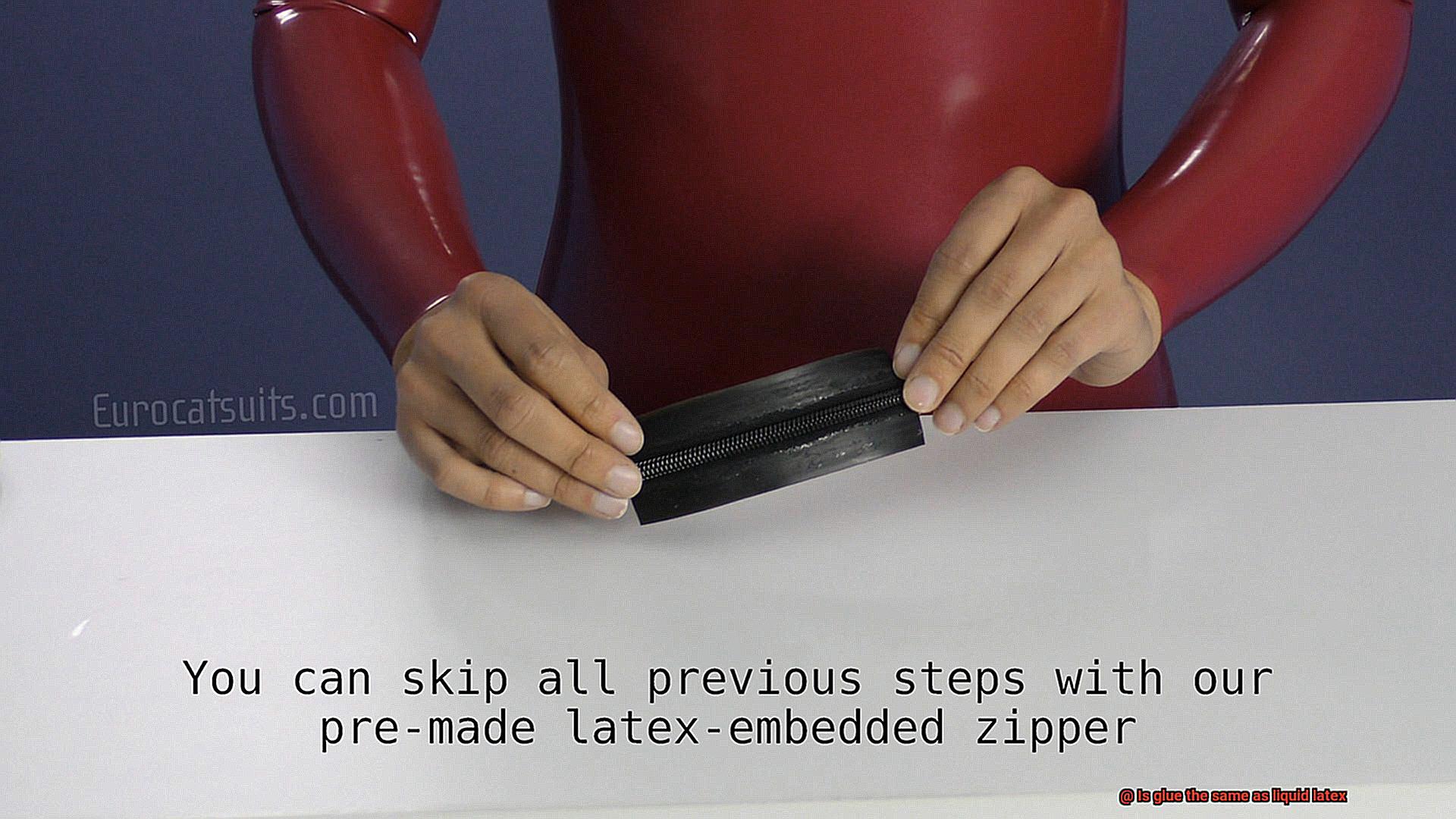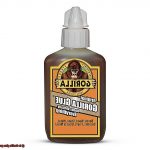Welcome to our blog post, where we dive deep into the intriguing question: “Is glue the same as liquid latex?”
Sure, they both stick stuff together, but trust us, they’re more different than you might think. Glue, that sticky marvel made from nature or man-made magic, is your go-to for everyday projects like fixing broken things and getting crafty.
On the flip side, liquid latex – straight from the rubber tree – brings a whole new level of coolness. We’re talking molds, mind-blowing makeup effects, and even body art.
Get ready to make some informed choices for your future projects.
What is Glue?
Contents
Glue, the magical adhesive that binds materials together, is a versatile substance found in various forms. Whether it’s a liquid, gel, or solid, glue has become an indispensable tool in arts and crafts, woodworking, construction, and countless other industries.
The fundamental purpose of glue is to create a strong and durable bond between two surfaces. As it dries or cures, glue adheres to the surfaces and forms an unbreakable connection. Glue can be crafted from a variety of materials, ranging from natural substances like animal hides or bones to synthetic wonders such as polyvinyl acetate (PVA) or cyanoacrylate.
Each type of glue possesses unique properties designed for specific applications. Wood glue, for instance, is specially formulated to provide an exceptionally sturdy bond on wood surfaces. Fabric glue, on the other hand, is engineered to join fabrics without causing damage. Specialized glues exist for bonding plastics, metals, ceramics, and an array of other materials.
Glue can be categorized into two main groups: solvent-based glues and water-based glues. Solvent-based glues contain volatile organic compounds (VOCs) that evaporate during the drying process, creating a potent bond. Though these glues often possess a pungent odor and necessitate proper ventilation, they are known for their formidable strength.
Water-based glues offer a safer and more environmentally friendly alternative. Free from harmful solvents, they are easily cleaned up with water. However, these glues may require longer drying times and may not exhibit the same level of strength as their solvent-based counterparts.
What is Liquid Latex?
Liquid latex is a versatile adhesive that has found its place in various artistic and practical applications. This milky liquid dries into a flexible and rubbery material, making it different from traditional transparent or white glue. One of the main components of liquid latex is natural rubber latex, which is derived from the sap of the rubber tree. Mixed with other ingredients like ammonia and water, it forms a liquid form that can be easily applied onto surfaces.
One of the key advantages of liquid latex is its high elasticity. Unlike regular glue, liquid latex can stretch and flex without breaking, making it ideal for applications that require flexibility, such as creating molds or prosthetics. Additionally, it exhibits excellent adhesion properties, allowing it to bond strongly to various materials like fabric, wood, plastic, and even skin. Its versatility in adhering to different surfaces makes it a popular choice in crafts and projects.
Another distinguishing feature of liquid latex is its ability to create a protective barrier. When applied onto surfaces, it forms a thin layer that acts as a protective coating, guarding against moisture, dust, and other environmental factors. This barrier helps prevent damage and ensures longevity.
Furthermore, liquid latex is water-resistant once it fully dries. It can withstand exposure to water and moisture without losing its adhesive properties. This attribute makes it suitable for applications in wet environments or where waterproofing is necessary.
One notable application of liquid latex is in special effects makeup and prosthetics. Its ability to create realistic textures and finishes makes it indispensable in creating wounds, scars, and other special effects for film, theater, and cosplay.
Differences between Glue and Liquid Latex
Glue and liquid latex may both be adhesives, but they couldn’t be more different. From their composition to their application, drying time to flexibility, strength to versatility, and safety considerations, these two adhesive options have distinct characteristics that set them apart.
Firstly, let’s talk composition. Glue is a concoction of chemicals like polymers, resins, solvents, and additives. This blend gives glue its bonding prowess and ability to stick to various surfaces. On the other hand, liquid latex is a natural material extracted from the sap of rubber trees. After undergoing processing to rid it of impurities, it becomes a liquid adhesive.
When it comes to application, glue offers various forms such as liquid, paste, and solid sticks. You can brush it on, apply it with an applicator, or even use it directly from the container. In contrast, liquid latex finds its primary use in special effects makeup applications like creating prosthetics and masks. It is best applied using a brush or sponge and needs time to dry before further manipulation.
Drying time is another factor that sets these adhesives apart. Glue typically dries faster than liquid latex. Depending on the type of glue used, it can set within minutes or take a few hours. Conversely, liquid latex takes longer to dry and needs sufficient time to form a stable bond. Factors like temperature and humidity can affect drying times for both adhesives.

Flexibility is where glue and liquid latex truly diverge. When glue dries, it hardens and becomes rigid, making it ideal for bonding stiff materials together. In contrast, liquid latex retains its flexibility even after drying. This quality makes it perfect for applications requiring movement, such as wearable prosthetics or masks that need to react to facial expressions.
Strength is another key difference between these adhesives. Glue typically forms a robust bond between surfaces, providing a secure hold. While liquid latex can create a relatively strong bond in certain applications, it may not match the strength of glue in all situations. It’s crucial to consider the project requirements and choose the adhesive accordingly.
In terms of versatility, glue takes the lead. It is a widely used adhesive that can bond various materials like paper, wood, fabric, and plastic. With different formulations available, it can cater to specific applications. On the other hand, liquid latex has more limited uses and primarily finds its place in special effects makeup and prosthetic creation. It may not be suitable for general-purpose bonding.
Lastly, safety considerations are vital when working with adhesives. Glue often contains chemicals that can emit fumes or cause skin irritation. It’s necessary to work in a well-ventilated area and take precautions when using glue. Liquid latex, being a natural material, is generally considered safe for use on the skin. However, individuals with latex allergies or sensitivities should test for adverse reactions before extensive use.
Uses of Glue and Liquid Latex
Glue and liquid latex are both versatile adhesives with distinct uses in various applications.
Glue, made from polymers, bonds a wide range of materials together. Its uses include:
- Woodworking: Glue is vital for joining pieces of wood in furniture making or intricate designs.
- Arts and Crafts: Glue is a staple for paper collage, scrapbooking, and sticking materials like fabric or plastic.
- Construction and Repair: Glue fixes broken objects and secures materials like metal, plastic, or ceramic.
Liquid latex, a liquid rubber, has unique applications:
- Mold Making: Artists use liquid latex to create molds for casting objects, capturing intricate details before reproducing them with materials like plaster or resin.
- Special Effects Makeup: Liquid latex is applied to the skin to create realistic scars, wounds, aging effects, and prosthetics for movies or theater productions.


One significant difference lies in their chemical composition and drying process. Glue contains solvents that evaporate as it dries, leaving behind a solid bond. Liquid latex dries through coagulation, transforming into a rubber-like material.
Moreover, glue offers stronger adhesion for permanent bonding, while liquid latex provides flexibility and moldability for complex shapes or temporary attachments.
Drying Time and Curing Process of Glue and Liquid Latex
The drying time and curing process of glue and liquid latex are essential factors to consider when working with these adhesives. Glue typically dries through evaporation, with the liquid components evaporating into the air. This process can be influenced by factors such as humidity, temperature, and the type of glue being used. Depending on these factors, most glues dry within a few hours to a day.
On the other hand, liquid latex undergoes a curing process. When liquid latex is applied, it starts to solidify as the water content evaporates. However, this initial drying phase is not enough for the latex to reach its full strength and elasticity.
To fully cure, liquid latex requires exposure to air and time. As the latex dries initially, it forms a thin layer on the surface that allows air to penetrate further into the material.
The oxygen in the air triggers a chemical reaction within the latex, causing it to cross-link and form a strong and flexible rubbery material. The curing process of liquid latex can take anywhere from 24 hours to several days.
Temperature also plays a role in the drying and curing processes of glue and liquid latex. Glue generally dries faster in warmer temperatures due to faster evaporation. However, extreme heat can affect the quality of the bond formed by the glue.
Liquid latex, on the other hand, cures better in cooler temperatures as excessive heat can cause it to dry too quickly, resulting in a less flexible and brittle end product.
Humidity and airflow are additional factors that can affect drying and curing times. Higher humidity levels can slow down these processes for both glue and liquid latex. It is best to work in well-ventilated areas or use fans to improve airflow and speed up drying or curing times.
Chemical Composition of Glue and Liquid Latex
Glue and liquid latex are two adhesive materials with unique chemical compositions that contribute to their adhesive properties. Let’s dive deeper into the fascinating world of these substances and explore their intriguing ingredients.
Glue, also known as adhesive, is a powerful bonding agent that relies on a combination of polymers, solvents, and additives. Polymers such as polyvinyl acetate (PVA) or cyanoacrylate are the foundation of glue’s adhesive strength. These polymers consist of repeating subunits called monomers, which create a strong bond between surfaces.
Solvents are essential components of glue as they dissolve the polymer and aid in application. Water and organic solvents like acetone or toluene are commonly used in glue formulations. These solvents evaporate once the glue is applied, allowing the polymer to form a solid bond.
Additives are like secret ingredients that enhance specific properties of glue. They can include fillers for viscosity or strength improvement, plasticizers for flexibility, or preservatives for shelf life extension. These additives give glue its unique characteristics and make it suitable for various applications.
On the other hand, liquid latex is a versatile material used in mold making, special effects, and body art. Its chemical composition primarily consists of natural latex, ammonia, water, and curing agents. Natural latex is derived from rubber trees and contains proteins called polyisoprenes. These polyisoprenes form the basis of the rubbery texture in liquid latex.
Ammonia plays a crucial role in stabilizing the natural latex and preventing premature coagulation. It also aids in the curing process by allowing the liquid latex to solidify when exposed to air. Water acts as a diluent, adjusting the viscosity of liquid latex for easy application. As water evaporates over time, liquid latex transforms into a solid rubber material.
In addition to these main components, liquid latex may contain small amounts of other additives like antioxidants or preservatives to ensure its longevity.
Interchangeability of Glue and Liquid Latex
The interchangeability of glue and liquid latex is a topic that often arises in the crafting and artistic community. While both substances serve as adhesives, it is important to recognize that they have distinct characteristics and purposes. Understanding these differences will help ensure that you select the right adhesive for your specific needs.
One key difference between glue and liquid latex lies in their composition. Glue is typically a mixture of polymers, solvents, and additives, whereas liquid latex is derived from the sap of the rubber tree. This distinction affects their drying and bonding properties. Glue dries and hardens, creating a strong bond between surfaces, while liquid latex remains flexible even after it dries. This flexibility makes liquid latex ideal for applications such as creating molds or special effects in movies or theater.
Another important factor to consider is the specific applications for which glue and liquid latex are designed. Glue comes in various forms such as white glue, wood glue, and super glue, each formulated for specific purposes.
For example, white glue is commonly used for paper crafts and general bonding, while wood glue is designed to create strong bonds on wood surfaces. On the other hand, liquid latex is primarily used for creating molds or as a body adhesive for costumes or prosthetics.
The drying time also differs between glue and liquid latex. Glue generally dries faster, allowing for quicker completion of projects. Liquid latex, on the other hand, may take several hours or even days to fully dry depending on its thickness. This longer drying time can be advantageous in certain situations where adjustments or layering are required.
Furthermore, the bonding strength of glue and liquid latex varies. Glue is known for its durability and strong bond, making it suitable for permanent applications. In contrast, liquid latex can be easily peeled off or removed without causing damage. This property makes it ideal for temporary applications or situations where repositioning or removal is necessary.
It’s worth noting that there are instances where glue and liquid latex can be used together in a complementary manner. For example, when creating special effects makeup, liquid latex can be used to create texture or build up layers, while glue can be used to attach additional elements like prosthetic pieces or accessories.
QCeyVVX5LGo” >
Conclusion
In conclusion, glue and liquid latex may share the common purpose of adhesion, but they are far from being identical twins. Glue, a versatile concoction of polymers, solvents, and additives, is the go-to adhesive for everyday projects like woodworking, arts and crafts, and construction. Its robust bonding properties come in various forms tailored to specific applications.
On the flip side, liquid latex stands as a distinctive adhesive derived from the sap of rubber trees. As it dries into a flexible and rubbery material, it becomes the perfect companion for tasks that demand movement or flexibility. Mold making, special effects makeup, and body art all bow down to the prowess of liquid latex.
When it comes to composition, glue and liquid latex couldn’t be more dissimilar. Glue boasts a chemical cocktail of polymers and solvents while liquid latex prides itself on its natural latex foundation enriched with ammonia and water.
Drying time, post-drying flexibility, bond strength, versatility in applications—these are just some factors that set glue apart from its liquid latex counterpart. While glue excels at permanent bonding across a wide range of materials, liquid latex triumphs in creating temporary attachments or intricate shapes that require flexibility.
To ensure successful outcomes in your projects—be it fixing broken things or unleashing your creativity through molds or special effects makeup—it is crucial to grasp the unique characteristics of each adhesive.






